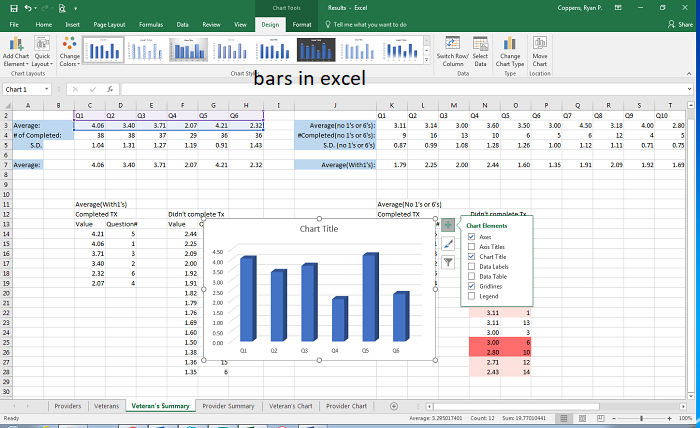
Excel is a powerful tool for data analysis and visualization, widely used across various fields. One of its useful features is the ability to add error bars, which help represent data variability and provide a clear visual indication of uncertainty in your measurements. In this guide, we’ll walk you through the process of adding error bars in Excel, from basic steps to advanced customization options.
Error Bars
Before we delve into how to add error bars in Excel, it’s important to understand what error bars are. Error bars are graphical representations of the variability of data. They indicate the uncertainty or error in the data points, making them crucial for data analysis, especially in scientific research and statistical analysis.
Types of Error Bars
Excel allows you to add different types of error bars, including standard error, standard deviation, and custom error values. Knowing which type to use depends on your specific data and the analysis you are performing. Each type provides different insights into the data’s variability.
Preparing Your Data
Before you can add error bars in Excel, you need to have your data properly organized. Ensure that your data is arranged in columns or rows and that you have calculated the necessary error values if you plan to use custom error bars. This preparation is crucial for accurately adding error bars in Excel.
Creating a Basic Chart
To start adding error bars in Excel, you first need to create a chart. Select the data you want to visualize, go to the “Insert” tab, and choose the type of chart that best represents your data. Common choices include line charts, bar charts, and scatter plots. Having a chart ready is the first step to adding error bars in Excel.
Adding Standard Error Bars
Once your chart is ready, you can add standard error bars. Click on the chart to select it, then go to the “Chart Tools” section. Under the “Layout” or “Format” tab (depending on your version of Excel), look for the “Error Bars” option. Here, you can choose “Standard Error” to add error bars that represent the standard error of the data points. This is a straightforward way to add error bars in Excel.
Adding Standard Deviation Error Bars
If you prefer to use standard deviation as your measure of error, Excel makes it easy. In the “Error Bars” menu, select “Standard Deviation.” This will add error bars that represent the standard deviation of your data, giving you a visual representation of data spread. Adding standard deviation error bars in Excel can provide a more comprehensive view of data variability.
Customizing Error Bars
To add error bars in Excel with custom values, select “More Error Bars Options” from the “Error Bars” menu. Here, you can enter specific values for positive and negative error bars. This option is useful when you have calculated error values from your data and want to precisely represent them. Customizing error bars in Excel allows for greater flexibility and accuracy.
Formatting Error Bars
Once you add error bars in Excel, you might want to format them to improve the chart’s readability. You can change the color, width, and style of the error bars by right-clicking on them and selecting “Format Error Bars.” This customization helps make your charts more visually appealing and easier to interpret.
Adding Error Bars to Specific Data Series
If your chart contains multiple data series, you can add error bars to specific series only. Click on the data series you want to add error bars to, then follow the same steps to add error bars in Excel as described earlier. This selective addition can help highlight particular aspects of your data.
Advanced Tips and Tricks
For more advanced users, Excel offers additional options for error bars. You can use formulas to dynamically calculate error bars based on other cells, or use VBA (Visual Basic for Applications) to automate the process of adding error bars in Excel. These advanced techniques can save time and enhance the precision of your data visualization.
Conclusion
Adding error bars in Excel is a valuable skill for anyone involved in data analysis. Whether you are a student, researcher, or professional, knowing how to add error bars in Excel can significantly improve the accuracy and readability of your charts. By following the steps outlined in this guide, you can confidently add and customize error bars in Excel to suit your specific needs.
FAQs
What are error bars and why are they important?
Error bars are graphical representations of data variability. They indicate the uncertainty or error in the data points, helping to provide a clear visual indication of data reliability. Adding error bars in Excel is important for accurately representing the variability and uncertainty in your data.
Can I add error bars to any type of chart in Excel?
Yes, you can add error bars in Excel to various types of charts, including line charts, bar charts, and scatter plots. The process of adding error bars in Excel is similar across different chart types.
How do I customize error bars in Excel?
To customize error bars in Excel, right-click on the error bars and select “Format Error Bars.” Here, you can change the color, width, and style of the error bars to improve the chart’s readability. Customizing error bars in Excel allows for better visualization and interpretation of your data.
Can I add custom error values to my error bars in Excel?
Yes, Excel allows you to add custom error values to your error bars. In the “Error Bars” menu, select “More Error Bars Options” and enter specific values for positive and negative error bars. Adding custom error bars in Excel is useful when you have calculated error values that need to be precisely represented.
What are the advanced options for adding error bars in Excel?
Advanced options for adding error bars in Excel include using formulas to dynamically calculate error bars based on other cells and using VBA (Visual Basic for Applications) to automate the process. These advanced techniques can enhance the precision and efficiency of adding error bars in Excel.



